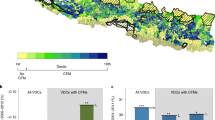Abstract
One of the key goals of social forestry is to involve the poor as project beneficiaries. It is possible to measure the degree of attainment of this goal by collecting socioeconomic data before and after project implementation. This approach cannot be applied at the many sites where ex-ante data were never gathered. This article proposes a methodology for evaluating the degree of inclusion of the poor in social forestry using ex-post data alone. Longitudinal analysis is approximated through the use of ‘slow change’ socioeconomic variables and through logistic regression. The methodology is illustrated with data on the Java Social forestry Program.
Similar content being viewed by others
References
Campbell DT and Stanley JC (1963) Experimental and Quasi-Experimental Designs for Research. Houghton Mifflin Company, Boston, MA, USA
Colchester M (1994) Sustaining the forests: the community-based approach in South and South-East Asia. Development and Change 25(1): 69-100
Gregersen H, Draper S and Elz D (eds) (1989) People and Trees: The Role of Social Forestry in Sustainable Development. EDI Seminar Series. The World Bank, Washington, DC, USA
Malhotra KC and Poffenberger M (eds) (1989) Forest Regeneration Through Community Protection: The West Bengal Experience. Proceedings of the Working Group Meeting on Forest Protection Committees, Calcutta, June 21–22, 1989
Mellor JW (1969) The subsistence farmer in traditional economies. In: Wharton CR (ed) Subsistence Agriculture and Economic Development, pp 209-227. Aldine Publishing Company, Chicago, IL, USA
Pasicolan PN (1996) Tree growing on different grounds: analysis of local participation in contract reforestation in the Philippines. Centre for environmental Studies, Leiden University, the Netherlands
Peluso NL (1986) Report on social forestry research in West and Central Java, October 1984–October 1985. Report prepared for the State Forestry Corporation and the Ford Foundation
Peluso NL (1992) Rich Forests, Poor People: Resource Control and Resistance in Java. University of California Press, Berkeley, CA, USA
Peluso N and Poffenberger M (1989) Social forestry in Java: reorienting management systems. Human Organization 48(4): 333-344
Rao VVB (1984) Poverty in Indonesia: Trends, Associated Characteristics and Research Issues. The World Bank, Washington, DC, USA
Sajogyo (1980) Masalah kecukupan pangan dalam jalur-jalur pemerataan. Prisma. No. 9
Sajogyo and Wiradi G (1985) Rural poverty and efforts for its alleviation in Indonesia: a sociological review. Food and Agriculture Organization
Scott JC (1976) The Moral Economy of the Peasant: Rebellion and Subsistence in Southeast Asia. Yale University Press, New Haven, CT, USA and London, UK
Seymour FJ (1991) Social forestry on public lands in Indonesia: a blurring of ends and means. Case study presented at the conference 'social Forestry: Communal and Private Management Strategies Compared', February 14, SAIS, The Paul H. Nitze School of Advanced International Studies, Johns Hopkins University, Baltimore, MD, USA
SFC (State Forestry Corporation) (1988) Pedoman Pelaksanaan Perhutanan Sosial. Perum Perhutani, Jakarta, Indonesia
Shah T (1988) Gains from social forestry: lessons from West Bengal. Discussion Paper, No 243. Institute of Development Studies, University of Sussex, UK
Simon H and Wiersum KF (1992) Taungya cultivation in Java, Indonesia: agrisilvicultural and socioeconomic aspects. In: Jordan CF, Gajaseni J and Watanabe H (eds) Taungya, Forest Plantations with Agriculture in Southeast Asia. Sustainable Development Series No. 1, pp 101-111. CAB International, Wallingford, UK
Skutsch MM (1994) Social forestry as sustainable development: comparative strategies in Sri Lanka. Thesis, University of Enschede, the Netherlands, 283 pp
Suhita C and Chatterjee D et al. (1990) Integrating conservation and development: a case study of the socio-economic forestry complex at Arabari, West Bengal. Int Tree Crops J 6(2–3): 193-204
Sunderlin WD, Artono A, Palupi S, Rochyana and Susanti E (1990) Social equity and social forestry in Java: preliminary findings from four case studies. Overseas Development Institute, Social Forestry Network, Network Paper 10A, London, UK
Sunderlin WD (1993) Environment, equity, and the state: a perspective through the Java Social Forestry Program. Ph D dissertation, Department of Rural Sociology, Cornell University, Ithaca, NY, USA
Sunderlin WD (1994) Bureaucracy and equitable development: the Java Social Forestry Program. East-West Center Working Papers, Environment Series, No 35, March. East-West Center, Honolulu, HI, USA
Wiersum KF (1994) Social forestry in South and South-East Asia: history and new perspectives. In: Simon H et al. (eds) Social Forestry and sustainable Forest Management. pp 1-27. Perum Perhutani, Jakarta, Indonesia
World Bank (1990) Indonesia: Strategy for a Sustained Reduction in Poverty. The World Bank, Washington, DC, USA
Author information
Authors and Affiliations
Rights and permissions
About this article
Cite this article
Sunderlin, W.D. An ex-post methodology for measuring poor people's participation in social forestry: an example from Java, Indonesia. Agroforestry Systems 37, 297–310 (1997). https://doi.org/10.1023/A:1005977907533
Issue Date:
DOI: https://doi.org/10.1023/A:1005977907533




